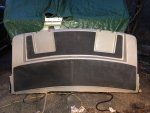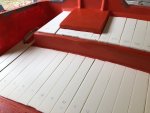I'm still thinking about the reinforcing around the inside of the aft perimeter. I need to have a vinyl foam board backing material for the rubrail on the outside perimeter to screw into. I also need to provide some thickness around the perimeter for strength.
Also, I have been figuring out the amount of resin to prepare for the infusion, I have done some refinements to my guesstimations. On the platform mold, I prepared 3 gallons of poly resin for the infusion. I will be doing the platform part itself with 2 separate infusions, with a hand layup and vacuum bagging of the core material. I need to plan out the resin for all 3 steps.
Here are the calculations that I have come up with so far, which I thought to share in case anyone is considering vacuum infusion.
The approximate sq footage of the part in all of its shape complexities is 44 sq. ft.
The initial infusion will be with the following layers of material and their associated thickness under compression (vacuum):
CSM (0.019")
1708 (0.027")
1708 (0.027")
WR (0.029")
The total is about 0.102" thickness for the outer layer of glass, which goes in the mold first, after the gelcoat has initially cured.
The 'volume' in the mold under vacuum will be as follows:
( 44 sq. ft. X 144 sq in/sq ft X 0.102 in. ) / 1728 cu. in/cu ft X 7.48 gals./cu. ft = 2.79 gallons (volume of the mold)
figuring the resin/cloth ratio will be about 50/50 for vacuum infusion, The volume of resin in the mold will be:
2.79 gallons X 0.50 = 1.40 gallons
Generally you would add 20-30% more resin for safety and loss through the distribution runners. So, I'll be preparing 2 or maybe 2.5 gallons of resin for the first infusion.
The second infusion may be a wee bit thicker than the first infusion, so that may get 2.5 - 3.0 gallons of resin.
I have 7 gallons of Vinyl Ester (VE) resin. The hatches will use about 24 oz of resin each, using similar calculations. So, I'll have about 1.5 gallons of resin for the hand layup of the core material.
We'll see how that all shakes out :noidea:


















